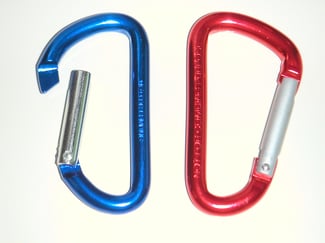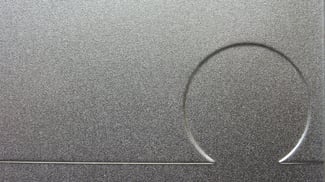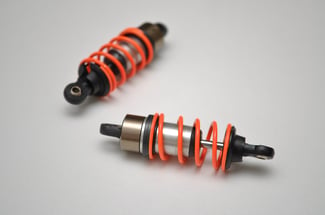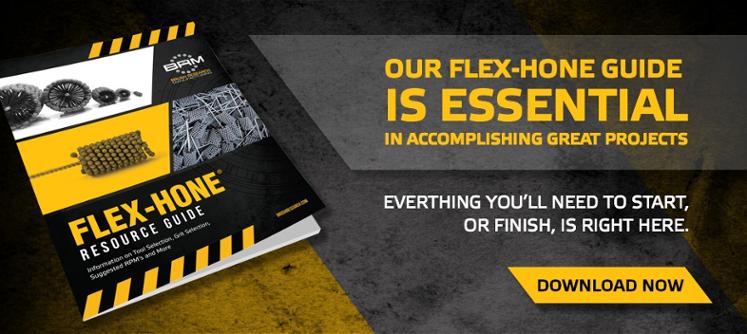 What do a blue-colored aluminum water bottle, a red-colored pen, and a rose-gold iPhone case have in common? They’re not colorful because they were painted. Instead, these items offer examples of color anodizing, one of several techniques that are used to decorate surfaces and provide a durable, protective coating.
What do a blue-colored aluminum water bottle, a red-colored pen, and a rose-gold iPhone case have in common? They’re not colorful because they were painted. Instead, these items offer examples of color anodizing, one of several techniques that are used to decorate surfaces and provide a durable, protective coating.
How does anodizing work? What other applications is it used for? And what does anodizing have to do with the Flex-Hone® tool for surface finishing? This two-part series from Brush Research Manufacturing (BRM) explains.
What Is Anodizing?
Anodizing, the process of electrochemically-converting the surface of an aluminum part to aluminum oxide, is so named because the metal part forms the anode, or positively-charged pole, of a complete electrical circuit. The cathode, or negatively-charged pole, is immersed in an electrolytic acid. Direct current (DC) converts the raw aluminum surface to non-conductive aluminum oxide while the electrolyte dissolves the coating. The process is complete when the oxide impedes current flow and can’t create a coating any faster than the acid can dissolve it.
 Anodizing provides increased resistance to abrasion, wear, and corrosion; reduces electrical resistivity; improves the adhesion of paints and primers; and supports the use of decoration through color anodizing. Anodic coatings are very hard and very porous, and anodized surfaces are tactile. There are several different types of anodizing methods, and each type or class reflects a range of coating thicknesses. As a rule, thicker coatings provide greater corrosion protection and, in harsh environments like salt air, this means longer-lasting surfaces.
Anodizing provides increased resistance to abrasion, wear, and corrosion; reduces electrical resistivity; improves the adhesion of paints and primers; and supports the use of decoration through color anodizing. Anodic coatings are very hard and very porous, and anodized surfaces are tactile. There are several different types of anodizing methods, and each type or class reflects a range of coating thicknesses. As a rule, thicker coatings provide greater corrosion protection and, in harsh environments like salt air, this means longer-lasting surfaces.
Class 1 and 2 are the thinnest types of regular anodic coatings. They meet specifications for clear and colored surfaces. Type II, or commercial-grade anodizing, has a thickness ranging from .0002 to .0008 per side. Type III (hard coating, hard anodize) is the thickest class with coatings ranging from .0005 to .003 per side. The most common Type III thickness is .002.
What Kinds of Parts are Anodized?
Anodized parts are used in many different applications. Examples include:
|
Electronics |
Cookware |
|
Appliances |
Marine |
|
Aviation |
Sporting Goods |
|
Automotive |
Food Preparation Equipment |
|
Machined Parts |
Hydraulic Cylinders |
|
Lighting |
Pneumatic Cylinders |
|
Furniture |
Architectural Products, Window, Doors, Railings |
For Flex-Hone® users, it’s important to note that many cylinders are anodized to impart a wear-resistant coating that permits the use of aluminum instead of other, heavier metals. Anodized aluminum cylinders are commonly used in lift mechanisms for chairs and as lift cylinders for hatchbacks. Anodized cylinders are also used as shock absorbers and forks for bicycles, fuel pumps, water pumps, spool valves, valve stems, and valve bodies.
How Anodizing Affects Cylinder Dimensions and Surface Finish
 When aluminum cylinders are anodized, their outer diameter (OD) increases and their inner diameter (ID) decreases. Remember that anodizing converts aluminum to aluminum oxide. Because this chemical compound occupies about twice the volume of raw aluminum, anodized parts “grow” dimensionally. Specifically, the oxide layer grows-out from the part’s surface at a faster rate than the aluminum is removed. This increases overall coating-thickness, but it’s important to note that part of this coating thickness is above the original surface and part is below the original surface. The difference between the surface coating and the original surface is called “build-up”. Anodizers can control the amount of dimensional change, and engineers generally account for this during product design.
When aluminum cylinders are anodized, their outer diameter (OD) increases and their inner diameter (ID) decreases. Remember that anodizing converts aluminum to aluminum oxide. Because this chemical compound occupies about twice the volume of raw aluminum, anodized parts “grow” dimensionally. Specifically, the oxide layer grows-out from the part’s surface at a faster rate than the aluminum is removed. This increases overall coating-thickness, but it’s important to note that part of this coating thickness is above the original surface and part is below the original surface. The difference between the surface coating and the original surface is called “build-up”. Anodizers can control the amount of dimensional change, and engineers generally account for this during product design.
Anodizing also changes surface finish – something that’s less commonly understood. After anodizing, an increase in surface roughness is normal. The amount of increased roughness depends on the type of anodizing process that’s used and the alloy that’s anodized. Generally, a hardcoat that’s anodized to a .002 thickness will result in a Ra that’s 2 to 3 times the original bare metal finish. For example, a machined Ra of 16 can easily become 30 Ra or more after anodizing. In addition, the anodized surface is very hard – only slightly less than diamond and harder than hard chrome plating.
If you’re making patio furniture or window frames, then these changes in Ra probably won’t concern you. The low-cost, durable finish that you’ve achieved is fine for your application. If you’re making components that mate with a seal, however, this surface roughness can be problematic. Remember that anodic coatings are very hard and increased surface roughness can abrade sealing materials. Seal wear and coating irregularities can provide a path for leaks. Ultimately, components such as shock absorbers, valves, pumps, and pneumatic and hydraulic cylinders require a fine surface finish for reliable sealing and long component life.
Stay Tuned. Learn More.
In Part 2 of this two-part series, we’ll examine how flexible honing improves the surface finish of anodized parts. In the meantime, and for more information about BRM Flex-Hone® tools for surface finishing, download the Flex-Hone® Resource Guide.









